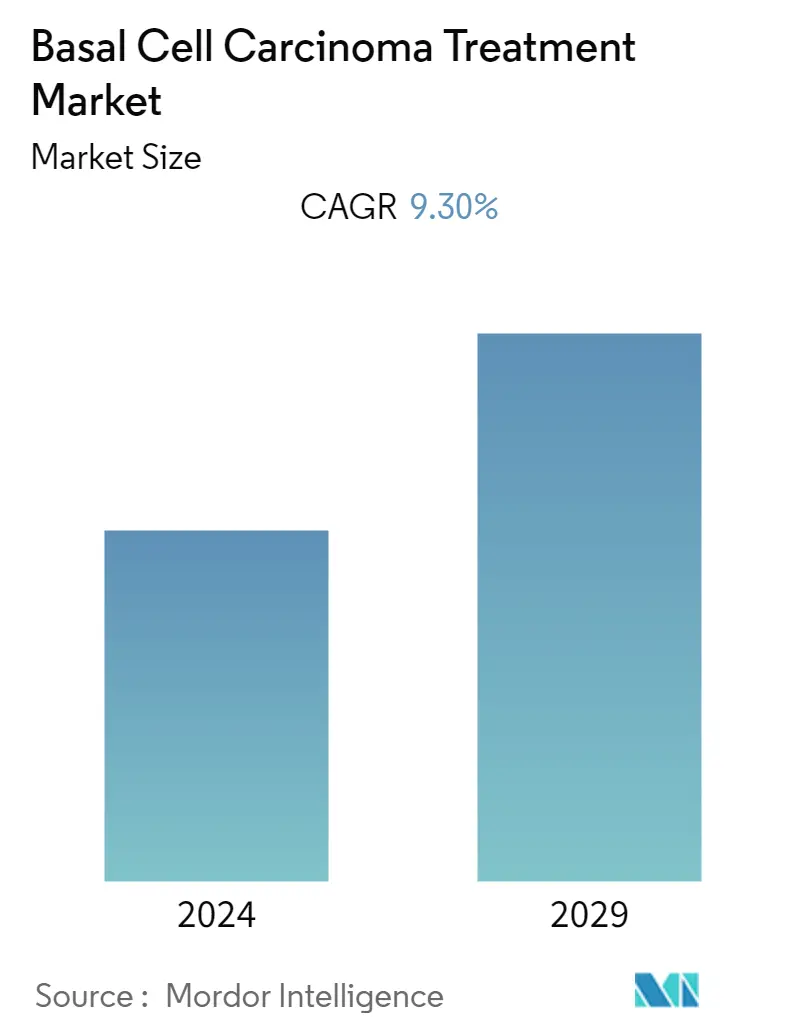Market Size of Basal Cell Carcinoma Treatment Industry

| Study Period | 2021 - 2029 |
| Base Year For Estimation | 2023 |
| CAGR | 9.30 % |
| Fastest Growing Market | Asia Pacific |
| Largest Market | North America |
| Market Concentration | Medium |
Major Players*Disclaimer: Major Players sorted in no particular order |
Need a report that reflects how COVID-19 has impacted this market and its growth?
Basal Cell Carcinoma Treatment Market Analysis
The Basal Cell Carcinoma Treatment Market is expected to register a CAGR of 9.3% over the forecast period.
The studied market was adversely impacted by the pandemic, and several research studies have provided insights into the direct effect of the outbreak on various diagnostic and surgical procedures related to cancer. The COVID-19 pandemic resulted in a sharp decline in non-urgent medical visits, according to a research article published in the National Library of Medicine in March 2021. Delayed appointments led to serious health consequences, such as the prolonged diagnosis of melanoma and other skin malignancies. As a result, there was a sharp decrease in all skin biopsies (15% of what was predicted), keratinocyte carcinoma (KC) biopsies (18%), and melanoma biopsies (27%). Thus, the market was unfavourably impacted by the outbreak in its initial phase. However, as per the analysis, initiatives undertaken by key market players, such as product approvals and developments, are augmenting market growth in the post-pandemic phase. For instance, in February 2021, the USFDA approved the intravenous immunotherapy medication, cemiplimab-rwlc (Libtayo), for the treatment of patients with certain forms of advanced basal cell carcinoma. Thus, with such approvals, the market is expected to grow during the forecast period.
The major factors attributing to the growth of the market are the increasing prevalence of skin malignancies, a rise in various environmental factors that lead to more UV exposure, and an increasing geriatric population that is more susceptible to skin diseases. According to a March 2022 article published by WCRFI, there are two primary forms of skin cancer, namely melanoma, and non-melanoma. Squamous cell carcinoma and basal cell carcinoma are the most typical non-melanoma cancers. The 17th most prevalent cancer worldwide is cutaneous melanoma. In terms of prevalence, it ranks 15th among cancers in women and 13th among cancers in men. In 2020, there were more than 150,000 new cases of cutaneous melanoma. Similarly, according to an article published by the American Academy of Dermatology Association in April 2022, skin cancer is the most prevalent type of cancer among Americans. According to current projections, one in five Americans may have skin cancer at some point in their lives. In the United States, an estimated 9,500 people receive a skin cancer diagnosis each day. More than 3 million Americans are thought to be affected annually by nonmelanoma skin cancer (NMSC), which includes basal cell carcinoma (BCC) and squamous cell carcinoma (SCC). Thus, the increasing prevalence of skin cancer is expected to boost market demand for treatments, in turn bolstering the market's growth.
Further, growing R&D activities related to basal cell carcinoma treatment are projected to propel the market's growth. For instance, at the American Society for Dermatologic Surgery (ASDS) Annual Meeting held in October 2022, the research study by Pulse Biosciences demonstrated that the CellFX procedure is effective for low-risk superficial and nodular basal cell carcinoma lesion clearance using Nano-Pulse Stimulation (NPS) technology. Such developments, coupled with the growing incidence of cancer, are likely to boost the market's growth.
However, the high cost of treatment and high susceptibility of basal cell carcinoma to remain underdiagnosed is expected to hinder the market's growth.
